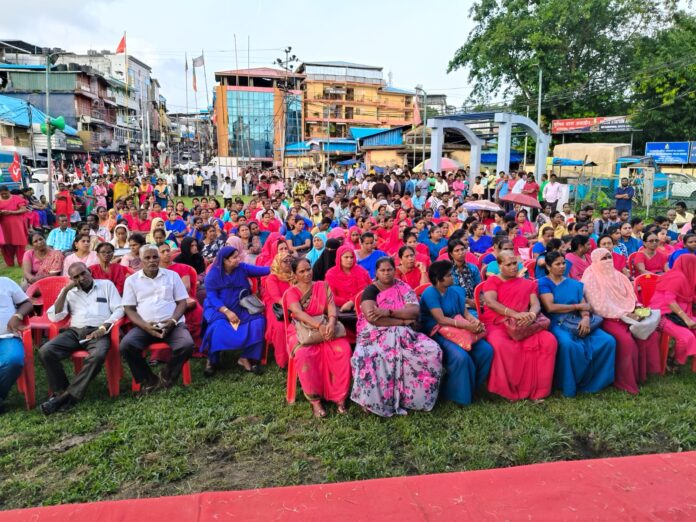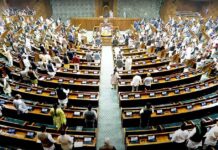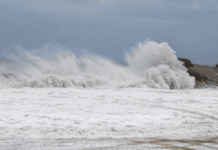Sri Vijaya Puram: In a show of solidarity with working-class movements across the country, hundreds of workers from various sectors in the Andaman and Nicobar Islands joined the one-day All India General Strike on Wednesday. The action, called by ten central trade unions and multiple independent federations, was aimed at protesting what organisers described as “anti-worker, anti-people” policies of the central government.
At the heart of the island-wide protests was Sri Vijaya Puram’s Tiranga Park, where unions affiliated with the Centre of Indian Trade Unions (CITU), the Indian National Trade Union Congress-Federation (INTUC-Federation), and Dravida Munnetra Kazhagam (DMK) Trade Unions led a mass sit-in and public meeting. Workers from the unorganised sector, Anganwadi workers, public utility staff, and contract labourers turned out in significant numbers.
Prominent trade union leaders including B. Chandrachoodan, General Secretary of the CITU State Committee; D. Ayyappan, Vice President of CITU; K.P. Usman, President of the INTUC-Federation; A.L. Kulandai of the DMK Trade Union; M. Yugandar; B.C. Bhattacharjee; and Anand Rajan addressed the gathering, listing both national and local demands. Among the key issues raised were the repeal of the four Labour Codes, restoration of the old pension scheme, enforcement of minimum wage at ₹26,000, and withdrawal of the Electricity (Amendment) Act, 2022.
The protest also gave voice to earlier unresolved concerns raised in the May 20 general strike, including the call for a halt to privatisation, fuel price rollbacks, and inflation control. At the island level, workers demanded regularisation of daily-rated and contract workers, fair wages for Daily Rated Mazdoors (DRMs), and full implementation of labour protection laws.
Across the territory, the scale of participation painted a picture of widening discontent. In Diglipur, CITU Zonal leaders Sunil Bepari and Barun Biswas led a public rally through the town’s main market. In Mayabunder, R. Muralidharan Pilli and C. Murugan marched through the jetty area, joined by Anganwadi workers and fisherfolk.
Similar processions were held in Kadamtala and Baratang. At Nilambur bazaar, the red flags moved past closed shops and onlookers, with Jayakumar and Daniel Aint leading the charge. Baratang’s rally culminated near the jetty, calling attention to job insecurity in tourism and construction.
On Swaraj Dweep (Havelock), a symbolic protest was staged in front of the Assistant Commissioner’s office, led by Suben Bachhar of CITU. In Campbell Bay on Great Nicobar Island, protestors led by Dhandapani of CITU and Siva Shanker of the Andaman Sarvajana Nala Vazhvu Munnetra Sangam (ASNVMS) assembled near the sub-divisional office demanding better labour rights for southernmost settlements.
In remote Katchal, where protests are rare, workers staged a sit-in outside the Andaman Public Works Department (APWD) office. Rajesh, Balmurugan, and Thyagarajan led the group, spotlighting grievances specific to remote island contract workers, including irregular pay and lack of grievance redressal.
Anganwadi workers and helpers observed the strike across multiple zones, including Sri Vijaya Puram, Ferrargunj, Baratang, Kadamtala, Mayabunder, and Swaraj Dweep. Bharat Sanchar Nigam Limited (BSNL) employees from the Andaman & Nicobar Telecom Circle also joined in, halting work for the day.
Though no major public disruption was reported, the symbolic message of unity and resistance was unmistakable. With issues such as contractualisation, wage stagnation, and poor social security being felt deeply across the islands, union leaders warned that unless corrective measures are taken, industrial unrest may deepen.
As of this report, there has been no formal response from the administration. However, the scale of the July 9 participation indicates that the government may need to revisit its approach to labour reform, especially in unionised regions like the Andaman and Nicobar Islands, where public sector and informal workforce constitute a majority of employment.
The protest wasn’t just about slogans and speeches. It was a call to be heard, from one end of the archipelago to the other.





